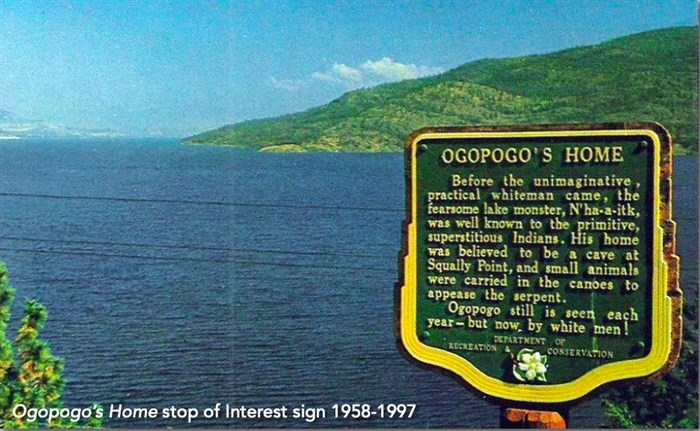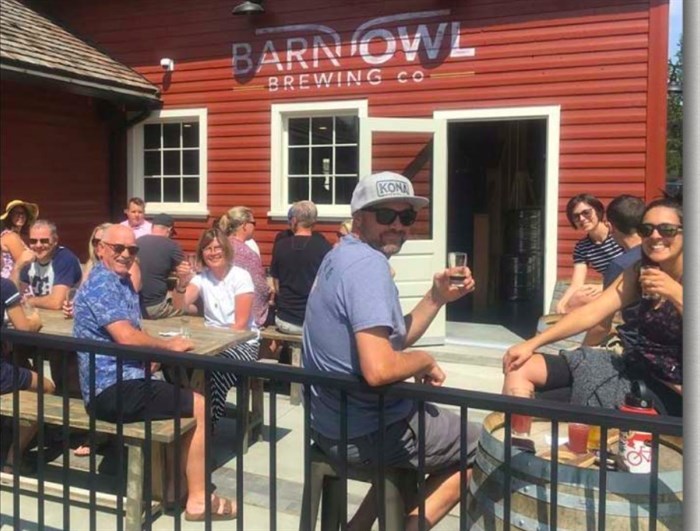
This old road sign its what once passed for heritage but misrepresented First Nations.
Image Credit: Submitted/City of Kelownal
February 05, 2021 - 6:30 AM
A whole new approach to heritage is emerging in B.C. and Kelowna could lead the way, according to a heritage consultant who gave city councillors a workshop on the subject earlier this week.
But what Elana Zysblat, the president of the B.C. Association of Heritage Professionals, said in Kelowna applies equally throughout the Thompson and Okanagan regions.
“If all we have to do is keep an old wooden structure standing and make sure it doesn’t deteriorate, that’s not a good business model,” she said. “We have to think about sustainability. Good conservation is about long term. Just protecting a building so it’s standing so that you can go and say: ‘Oh, this is how old mills worked,’ that’s not robust enough, justifiable enough nor, in my opinion, is it a relevant enough experience to be able to be sustainable.
“We have to push to bring in contemporary partners to create money making, relevant experiences so that young people today will want to come there again and again and again.”
Heritage is always evolving and should not be confined to static traditional museums where people may go once to look but can’t touch or interact with things so don’t go back.
In B.C., heritage conservation started in the 1920s following the establishment of the National Historic Sites and Monuments Board of Canada that consisted of white men who directed that stone cairns with brass plaques be erected to honour them, Zysblat said.
At that time heritage was mostly about buildings that represented European culture and traditions.
That was followed in the 1950s by the provincial Stops of Interest program that led to signs, like the one pictured above, about "Ogopogo’s Home," that was posted about half an hour south of Kelowna, Zysblat said.
It reads in part: “Before the unimaginative, practical Whiteman came, the fearsome lake monster, N,ha-a-itk, was well known to the primitive, superstitious Indians.”
Coun. Brad Sieben described it as “offensive.”
READ MORE: Sasquatch, Ogopogo and other Syilx spirits remind us to respect Okanagan environment
Even today, heritage is seen mostly as preserving old European buildings but it's changing.
That means, for one thing, recognizing that heritage is also about telling stories – sometimes dark stories – about a community’s past. Stories that include not only the First Nations but others who helped settle and build a community and have often been invisible.
Coun. Mohini Singh noted that, when Kelowna turned 100 in 2005, she made a video about the Indo-Canadian contribution to the city.
“To this day, that is the only documented piece of their history and we still use it today,” she said. “I’m afraid that, through the years, stories get forgotten.”
And, while it’s still important to preserve buildings, it has to be done in a braver and more flexible way, Zysblat said.
Heritage Conservation Agreements, which are now normally used to preserve buildings in their original state, can become much more creative and used as tools of change as opposed to burdens on property owners, Zysblat said.
She cited the example of a theatre in New Westminster that was being preserved by building a 25-storey tower next to it.
Serving beer in an old barn gives economic viability to an old building but it also brings people back again and again.
“If old places can be allowed to have relevant uses, they will never come at risk because they will be passionately protected by the community, not by legislation,” Zysblat said.

The redevelopment of the once boarded up Surtees barn is the type of "adaptive reuse" that ensures heritage buildings will be preserved.
Image Credit: Submitted/City of Kelowna
City of Kelowna staff are starting to document the more than 20-year history of its Abbott Street and Marshall Street heritage conservation areas to create a database. It will record things like how many homes have been demolished, renovated or altered.
That will be presented to council and lead into a more extensive review of the city’s approach to heritage.
“Kelowna is positioned to be a leader,” Zysblat said. “The work that needs to be done, in my opinion, is what almost every municipality in B.C. is looking at – a fresh articulation and rethink of the true story, a more inclusive story, of Kelowna. Because, if you look at the books that we have published and the places we’ve conserved or listed on our heritage register, if you go to the archives, it’s still quite an old school approach. Kelowna, in practice, is celebrated in a very different way. It’s a much more colourful town. It’s a much more inclusive town.”
There is no timeline on when the review will be done but Kelowna could be the first city in B.C. to revisit its approach to heritage that, like many other communities, was adopted in the last century.
That’s not going to sit well with many heritage advocates and activists but, Zysblat said, those people also need to be educated on the new ways of viewing heritage.
While they would be encouraged to sit on heritage advisory committees and train to become heritage professionals, such committees need to reflect the interests of the community as a whole, she said.
“Sometimes the best members of a heritage advisory committee happen to be a lawyer or an athlete or a very young student who has a passion about heritage but don’t have the heritage mindset,” Zysblat said.
Mayor Colin Basran suggested there may be common ground between heritage advocates and a council that is dealing with a lot of development applications, including many within the heritage conservation areas.
“It seems like they’re opposed to any changes in the heritage conservation area,” he said. “When we make our decisions we’re trying to find a balance. The way it’s viewed by some is: ‘You’re ignoring us. We weren’t heard.’”
He knows it could be a rough ride to make changes.
“This topic of discussion gets me down fairly often because of the conflict,” Basran said. “But, I’m really excited about the work that’s going to come in the heritage conservation areas. It’s not going to please everyone, obviously, but I would love for even just one of those groups, on occasion, to say we actually support this because we recognize things have to change in a dynamic community.”
READ MORE: Why Thompson-Okanagan cities are doomed to repeat heritage protection failures
To contact a reporter for this story, email Rob Munro or call 250-808-0143 or email the editor. You can also submit photos, videos or news tips to the newsroom and be entered to win a monthly prize draw.
We welcome your comments and opinions on our stories but play nice. We won't censor or delete comments unless they contain off-topic statements or links, unnecessary vulgarity, false facts, spam or obviously fake profiles. If you have any concerns about what you see in comments, email the editor in the link above.
News from © iNFOnews, 2021